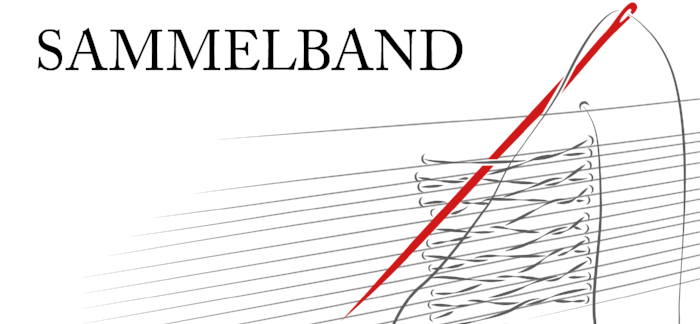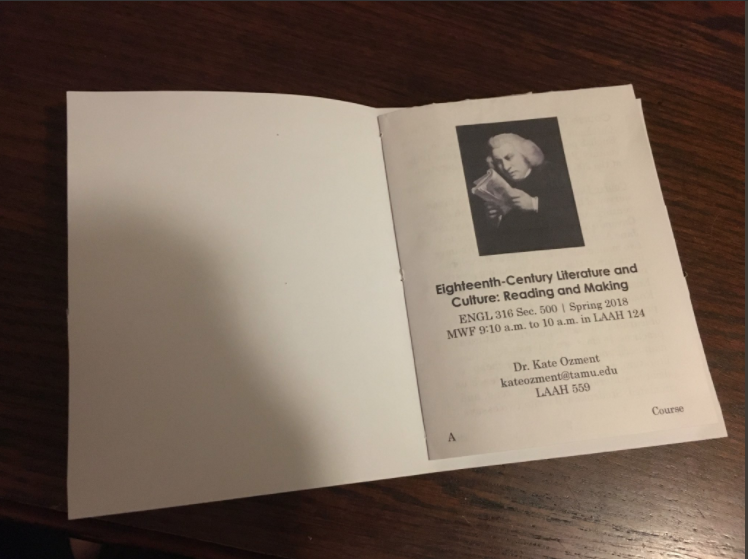Teaching Ephemera: Pamphlet Binding
Posted by Kate Ozment
As an undergraduate, I was drawn to eighteenth-century print culture and the flurry of interconnected pamphlets and periodicals that linked John Dryden, Jonathan Swift, Delarivier Manley, and Eliza Haywood. These exchanges, such as the satirical barbs between Swift and Lady Mary Wortley Montagu, continue to delight my students. Anthologies usefully collect these materials—and some such as Broadview have a facsimile—but as Laura C. Mandell has written, books tend to make a “monument” of texts that were written and printed in a fundamentally different mode. As my class discussed the Swift/Montagu exchange, one student derisively commented that anthologizing these works was the same as a future anthology collecting Buzzfeed listicles.
My students use Eighteenth-Century Collections Online to get an idea of what many of these texts originally looked like, but exploring their materiality is also an essential part of teaching print culture. Ephemera are fortunately inexpensive purchases for professors and librarians who are looking to build a teaching library (a topic we will discuss more in a later post). Jean Lee Cole’s chapter about teaching book history “on the fly and on the cheap” suggests purchasing inexpensive print periodicals and other ephemera to augment class discussion. She comments:
On its most visceral level, of course, students simply love touching the stuff! Many of them have never seen an old magazine before, much less a nineteenth-century children’s book or an eighteenth-century newspaper. Their contact with these items, especially in their original, real forms, gives them contact with a history, society, and culture that, simply through its passing, has become lost to them. (53)
I wholeheartedly second Cole’s observations about students’ interactions with original documents. Despite all my creative lesson planning, my students’ favorite days are when they get to handle documents and touch on a past that has been lost. While building a teaching library is an excellent way to bring ephemera into the classroom, I would like to add another suggestion from empirical bibliography—having them make their own pamphlets. Just as students love handling historical documents, they love making surrogates and mimicking the reading practices of the period.
The following is a description of how to teach a three-hole pamphlet binding exercise in a classroom setting.
This approach and the tools I suggest were adapted from a similar exercise that I participated in at Texas A&M’s Book History Workshop. Three-hole pamphlet stitches are very simple, and it is easy to find instructional videos online (I suggest this one or this one). I will briefly cover the basics here, but the emphasis will be on how to manage it in the classroom.
Image of a pamphlet with a yellow wrapper.
For some context about my prep and variables: I have a class of 35 students for the eighteenth-century survey that I planned this lesson for; while it would have been easier to have a helper in the classroom, the lesson went perfectly fine on my own. I am on a MWF schedule, so our class times are short at 50 minutes. With the shorter class time and large number of students, I first practiced this with four doctoral students who were willing let me work out my presentation style and indicated what needed to be better explained (thank you!).
For this project, each student will need:
Paper you would like them to bind together
Colorful paper for the wrapper (preferable)
Binding kit
I chose to have students bind a quarto pamphlet version of their syllabus. It let me engage them in the “making” part of the class theme early on, and it had an interesting side effect—they actually read their syllabus! This project also works with blank pages or any other content you can imagine, such as a facsimile of a pamphlet on the reading list. I chose a quarto because it fit my syllabus on two sheets of standard 8 in. x 11.5 in. printer paper. The way the documents are set up, one gathering should be placed inside of another and the stitch goes through both at the middle. Using larger paper, a different format, or a larger amount of text will change some of the provided directions. In a WBHB dropbox, I have included the InDesign file I used to set up the syllabus, a PDF example, and the PowerPoint file that I displayed during the lesson (also provided in a PDF). Page design software like InDesign is the best choice for setting up text boxes that work within your desired format, but if you do not have access to InDesign you can use the PDF to see what mine looked like.
Image of an open quarto syllabus
The binding kits fit in standard sandwich-size plastic bags and are the part of this that involves the most prep. You can buy pre-made bookbinding kits online, but they include more tools than you need for a three-hole pamphlet stitch and can be pricey. Each of my binding kits included the following:
Book binder’s needle
Scissors
Waxed linen thread
Bonefolder (alternatively, you can use bamboo)
Wooden awl
Thimble (optional)
In each kit, include a length of pre-cut thread that is three times the length of the spine of your intended pamphlet. I wrapped this string around a piece of cardboard to keep it from being tangled. You can include a spool in each bag and not have to replenish them as often, but the upfront costs will be higher to purchase that many spools. I also tucked the awl into the cardboard to keep the end from poking through the plastic bag. Again, for how to bind the pamphlet and the specific steps that I related in class, see the linked videos above and the documents in the dropbox.
We are in a larger classroom with a projector, so I used a PowerPoint with the steps written down while talking through what I was doing myself. I bound a pamphlet with my students as a demonstration. To keep things moving, I had students pick their colorful wrapper paper from the selection I brought in as they gathered in the classroom, which meant most students were sitting with their selection by the time class started.
The entire exercise took about 30 minutes of class, including answering questions. Most students left without cutting open their pamphlets, as I suggested using sharper scissors than I had provided to make the edges crisper. I have seen them pull these out of their bags to reference class policies, and it gave a much better picture of the authors we read in the following weeks. While reading John Dryden’s Mac Flecknoe, the students immediately understood how a poet’s work could wrap a pie or be used as toilet paper because they had the same size document in their hands.
The costs of this project are as follows:
Generic brand plastic sandwich bags with a zip top: 25 count, $3.99
Colorful paper for wrappers: scrapbook paper, 200 sheets on sale at Michael’s for $15
Book binder’s needles: from GTDFH, 5 for $9.55
Scissors: from Scotch, 12 for $15.27
Waxed linen thread: from Lineco natural color, 20 yards for $10.79
Bonefolder: from 4U-Lucky, 7 for $11.60
Wooden awl: from Dsmile Word, 5 for $7.99
Thimble: from LuGe, 30 for $8.88
I put together 35 binding kits using these materials for about $250, or $7.15 per kit. Printing the pamphlet syllabus itself was covered by my department. Of course, smaller class sizes would mean the cost of this exercise would decrease. The true benefit of this project is that after the initial upfront cost, it is very inexpensive to continue. Only the string and eventually the wrapper paper have to be replenished every semester.
I chose the cheapest option that still provided enough quality for the classroom because cost was paramount for me. Most of these vendors are on Amazon and may have varied stock, but I found the reviews very useful to see if cheap extended past the point of use. I have tried each of the linked products without issue for a quick classroom exercise. If you want quality tools, go to a reputable dealer like Blick or Hollander’s, and if you want to take up bookbinding as a fantastic new hobby, Hollander’s has a good selection of books on the topic.
As always, feel free to contact us with questions or suggestions. I wish you luck as you introduce your students to the joys of print culture!
Link to dropbox with materials: https://www.dropbox.com/sh/tlkg0lzywwsaixf/AADheTsG2TqmGDNOgHniYXQWa?dl=0
Works Cited
Jean Lee Cole, “History of the Book in the American Literature Classroom: On the Fly and On the Cheap,” in Teaching Bibliography, Textual Criticism and Book History, ed. Ann R. Hawkins (Routledge, 2006), 51–55.
Laura C. Mandell, Breaking the Book: Print Humanities in the Digital Age (Wiley-Blackwell, 2013).
About the Author
Kate Ozment is a doctoral candidate in English literature at Texas A&M University. She defended her dissertation on women's professional authorship and the eighteenth-century book trades in fall 2017, and she is currently working on a book project theorizing feminist bibliography with her WBHB co-editor, Cait Coker. Contact her at: kateozment (at) gmail (dot) com.
Want more Sammelband?
-
October 2022
- Oct 16, 2022 Teaching in the Maker Studio Part Two: Safety Training and Open Making
- Oct 16, 2022 Teaching Book Forms
- Oct 16, 2022 Teaching Letterpress with the Bookbeetle Press
-
September 2022
- Sep 24, 2022 Making a Scriptorium, or, Writing with Quills Part Two
- Sep 16, 2022 Teaching Cuneiform
- Sep 4, 2022 We're Back! Teaching Technologies of Writing
-
June 2020
- Jun 1, 2020 Black Lives Matter
- May 2020
-
April 2020
- Apr 1, 2020 Teaching Materiality with Virtual Instruction
- March 2020
-
February 2020
- Feb 1, 2020 Making the Syllabus Zine
-
January 2020
- Jan 1, 2020 Teaching Print History with Popular Culture
-
December 2019
- Dec 1, 2019 Teaching with Enumerative Bibliography
-
November 2019
- Nov 1, 2019 Finding Women in the Historical Record
-
October 2019
- Oct 1, 2019 Teaching in the Maker Studio
-
September 2019
- Sep 1, 2019 Graduate School: The MLS and the PhD
-
August 2019
- Aug 1, 2019 Research Trips: Workflow with Primary Documents
-
July 2019
- Jul 1, 2019 Research Trips: A Beginner's Guide
-
June 2019
- Jun 1, 2019 Building a Letterpress Reference Library
-
May 2019
- May 1, 2019 Teaching Manuscript: Writing with Quills
-
April 2019
- Apr 1, 2019 Why It Matters: Teaching Women Bibliographers
- March 2019
-
February 2019
- Feb 1, 2019 Roundup of Materials: Teaching Book History
-
January 2019
- Jan 1, 2019 Building and Displaying a Teaching Collection
-
December 2018
- Dec 1, 2018 Critical Making and Accessibility
-
November 2018
- Nov 1, 2018 Teaching Bibliographic Format
-
October 2018
- Oct 1, 2018 Teaching Book History Alongside Literary Theory
-
September 2018
- Sep 1, 2018 Teaching with Letterpress
-
August 2018
- Aug 1, 2018 Teaching Manuscript: Circulation
-
July 2018
- Jul 1, 2018 Setting Up a Print Shop
-
May 2018
- May 1, 2018 Teaching Manuscript: Commonplace Books
-
April 2018
- Apr 1, 2018 Getting a Press
-
March 2018
- Mar 1, 2018 Teaching Ephemera: Pamphlet Binding
- February 2018



